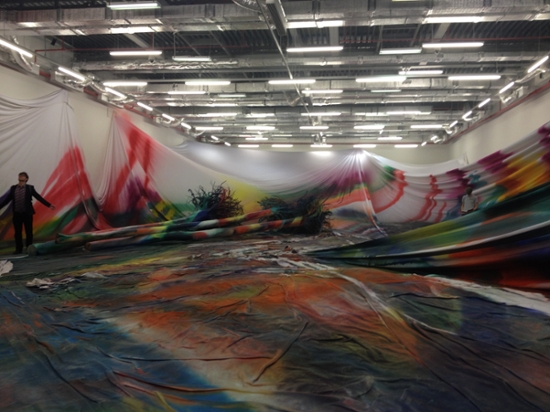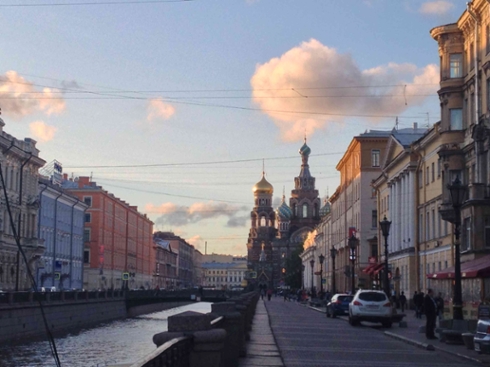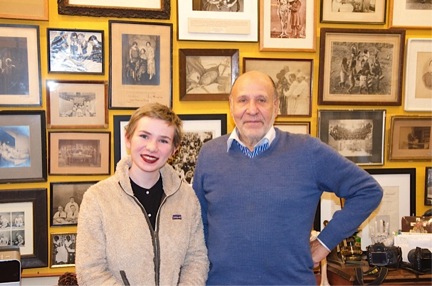Tags
"archive"
Presidents Summer Fellowship 2015, Impressions from Saint Petersburg Part 3, Orla O'Sullivan
Orla O'Sullivan '16, Russian major, is diving deep into the extensive collections at the State Hermitage Museum in Saint Petersburg, Russia, conducting research on visual culture and responses to controversial exhibitions for her President's Summer Fellowship.
The three months since returning from Russia have been a blur of starting my thesis, and running between classes, and intermittently, reflecting upon my trip. I feel inexplicably grateful for receiving the opportunity to intern at the Hermitage, study classical and contemporary Russian art, and learn how to articulate critical analyses using idiomatic Russian. I, moreover, feel so grateful for this opportunity to continually stretch my ability to move through and be comfortable in new situations, geographically, interpersonally, and linguistically. Thank you.
As my two prior posts express, I was, and continue to be, particularly interested to study Russian visual culture, civil society, and their influences. My project, which was founded upon three tiers of museum internship, art historical research, and language study aimed to examine these three aspects within a Russian cultural context, because the field is difficult to study and access in the U.S.
Continue reading Presidents Summer Fellowship 2015, Impressions from Saint Petersburg Part 3, Orla O'Sullivan
Presidents Summer Fellowship 2015 - Orla O'Sullivan - Part 2

yes no why later by Katharina Grosse, Garage Museum of Contemporary Art, Moscow
Orla O'Sullivan '16, Russian major, is diving deep into the extensive collections at the State Hermitage Museum in Saint Petersburg, Russia, conducting research on visual culture and responses to controversial exhibitions for her President's Summer Fellowship.
I’ve held off on my second post, because I’ve been struggling with the realization that my project, which had originally aimed to document others’ responses to contemporary art at the Hermitage, has had to take a different track, one which has been both more personally difficult and fulfilling than I had expected.
A few weeks into my internship, I realized that implementing my project per the original plan without going completely rogue was going to be nevozmozhno, impossible. What previously seemed like a fast-paced, ever-changing series of projects revealed itself as a series of events that should have been planned months ago, but were instead hastily assembled four days prior to their official presentation date. We could complain of a lack of helpers, but that would be inverting the truth. There’s no lack of helpers (the museum pumps out visas for students from impressive European universities like clockwork); there’s just no available record of them. So when some of the more determined volunteers do make an attempt to draft a project schedule or add a little logistical infrastructure, they usually become completely overwhelmed with the scale of their endeavor, the difficulty of contacting people, and the list of unfinished projects barreling toward their deadlines.
Continue reading Presidents Summer Fellowship 2015 - Orla O'Sullivan - Part 2
Presidents Summer Fellowship 2015, Orla O'Sullivan, Impressions from Saint Petersburg

Orla O'Sullivan, '16 Russian major, is diving deep into the extensive collections at the State Hermitage Museum in Saint Petersburg, Russia, conducting research on visual culture and responses to controversial exhibitions for her President's Summer Fellowship.
I was shocked to learn recently that pieces frequently go missing at the Hermitage Museum, which probably surprises no Russian person, but it did surprise me. No one is, as far as I can tell, fired (either the theft is hard to trace, or not much effort to trace it is exerted). There is media buzz for a few weeks and then that’s the end of it. I am as equally mesmerized by the Winter Palaces’ halls and the General Staff Building’s sheer scale, as I am amazed that this institution functions as well as it does. The archeological department on the fourth floor, for instance, is filled – and this is no hyperbolical statement – with at least thirty years of books. At least. There are books and quills and pens and more books and articles and stray papers and presentations and various Russian shtukis (“thingies”) all piled on the tables and floors – just everywhere. So it shouldn’t be any wonder that items go missing, although, the museum boasts both antiquated and cutting-edge conservation facilities.
On my first day interning, I spent 2 hours (literally) trying to find the door, and then, once I found it, was asked, would I please assist a three-day conference on virtual archeology, where I met some fascinating people, including an archeaometrist (someone who applies physics to archeology), an architect specializing in computer program semantics, and the archeology department director (who happens to be the cousin of the museum director). Since then, it has been a whirlwind: Attending an international congress on Peter the Great; planning a museum celebration of the European Union; labeling Old Russian rock fragments with quills and ink; translating documents from Russian into English; and, most recently, working on a presentation for an exhibition closing ceremony on Monday. There is no written or printed schedule – everything just seems to happen on a whim – and practically each day brings a new, completely unforeseen, project.
Continue reading Presidents Summer Fellowship 2015, Orla O'Sullivan, Impressions from Saint Petersburg
Burns Photography Archive, Winter Externship Program, Ray Self

As a participant in Reed’s winter externship program, Ray Self, sophomore History major, spent eight days working in New York City at the Burns photography archive.
This winter break, I spent eight days working at the Burns Archive, a photographic archive in New York City that specializes in early medical photography, in addition to having a wide range of collections covering a variety of other historical topics. The Archive has provided photographs and historical information for a number of film and television projects, most notably working on the Knick, a Cinemax series set in a hospital at the beginning of the 20th century.
I had the opportunity to aid in a range of different projects during my externship. Most notably, I was able to see firsthand how the Archive organizes their image collections, and how these images are selected and prepared for publication in their series of photographic books on various historical and medical topics. Because of the immense quantity of images that the Archive possesses, I was curious to learn about the organizational systems they had in place to manage the collection. I was expecting a complex computerized database of images, and was surprised to see they utilized a very different organizational method. Boxes full of photographs were given a label related to their historical topic, and stored in a special room equipped with a digital camera for image capture. Images were organized in a way that was functional to current projects; as assignments arose, collected images related to that topic were documented via the camera and organized in a more comprehensive fashion.
Continue reading Burns Photography Archive, Winter Externship Program, Ray Self
